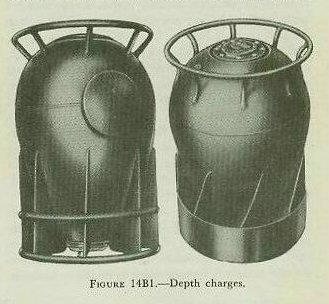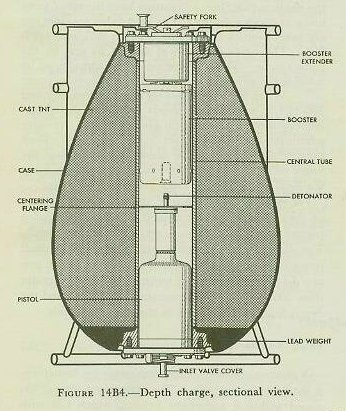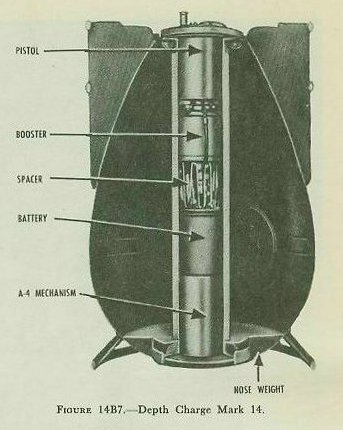| GENE SLOVER'S US NAVY PAGES NAVAL ORDNANCE AND GUNNERY VOLUME 1, NAVAL ORDNANCE CHAPTER 14 ANTISUBMARINE WEAPONS |
| HOME INDEX Antisubmarine Weapons A. Antisubmarine warfare B. Depth charges C. Depth bombs D. Throwing weapons E. Nets and booms |
| B. Depth Charges 14B1. General Depth charges are thin-walled containers filled with a heavy charge of explosive and designed to explode at a predetermined depth or by the action of an influence fuze. The older depth charges are cylindrical in shape, about 28 inches long and 18 inches in diameter. They contain 300 pounds of TNT. This type of depth charge, the Mark 6, is now used largely for training. An even larger cylindrical depth charge, the obsolete Mark 7, contained 600 pounds of TNT. The later types of depth charges, Mark 9 and Mark 14, have a teardrop shape and a weighted nose, to increase the sinking rate and improve the underwater trajectory. They contain about 200 pounds of TNT or of HBX and have the same over-all dimensions as the 300-pound cylindrical charge. Representative depth charges are shown in figure 14B1. |
 |
 |
 |
 |
 |
 |
 |
| The depth at which explosion will occur is controlled in the older type by setting a hydrostatic exploder mechanism which is graduated to 600 or 1,000 feet (in different mods). In the newer charges explosion is initiated by an influence-type firing mechanism. Neither type of exploder mechanism depends upon contact with a submarine. It is extremely difficult to obtain a direct hit with depth charges, because the exact position of the submarine usually is not known. Consequently, depth charges depend on the percussive wave of the explosion for their effectiveness. The effective radius of the percussive wave depends upon the structural strength of the attacked vessel, and no definite values can be stated. Approximate information indicates that a 600-pound charge may cause moderate damage at 80 feet, but to be fatal it must explode within about 30 feet. The 300-pound charge may prove fatal within 20 feet. It is to be noted that doubling the weight of charge does not double the effective radius. Destroyers, destroyer escorts, subchasers, PT boats, and other vessels likely to engage submarines, carry depth charges. Generally several charges are released in rapid succession to form a pattern in depth, width, and length, and thus increase the probability of destroying the submarine. The pattern is obtained by dropping some charges from release gear on the stern, and firing others abeam from projectors, with appropriate depth settings made on the depth charges before launching. The charges are never thrown far from the attacking vessel; hence care must be taken that the ship is making sufficient speed to be out of the way of the violent effect produced. The computation of the speed necessary is considered to be part of the antisubmarine fire control problem, which is discussed in volume 2. |
| 14B2. Release gear One type of track used to drop depth charges from the stern of a vessel is illustrated in figure 14B2. Essentially, it consists of inclined rails on which the charges rest, with suitable mechanical devices arranged to release one charge at a time. The track shown will hold eight Mark 6 charges. Minor modifications make the track suitable for dropping teardrop charges. The charges roll aft by their own weight and rest against the after detents. When the release lever is operated, the after detents depress, allowing the first charge to roll off the track into the water. At the same time, forward detents (not shown) rise and hold the second and following charges steady on the rails. When the track control lever is returned to its original position, the detents move in reverse directions, and the second charge rolls down to the dropping position against the after detents. The track control unit is connected hydraulically to a control unit on the bridge of the ship by means of which the charges may also be released. Most depth-charge release tracks bear mark and mod designations. Four tracks, however, have letter designations instead. All four of these tracks are intended primarily for use on small vessels and motor boats, although they have been grouped along the sides of somewhat larger craft on occasion. All have cable pendants for holding the depth charge (or pair of charges) in place. All have built-in local control devices. Types A and C hold a single charge; types B and D are designed to hold two charges. They are dropped by releasing the cables which hold the case in position and letting the charge roll from the track. |
| 14B3. Projectors The Depth Charge Projector Mark 6 Mod 1, commonly called the K-gun, is illustrated in figure 14B3. It is used to launch the 300-pound cylindrical depth charge or the 200-pound teardrop charge. The K-gun consists of a smooth-bore barrel attached to an expansion chamber fitted with a breech mechanism. The breech plug is an interrupted-screw type, housing a firing mechanism which provides for local percussion firing by lanyard, or electrical firing controlled from the bridge. The projector is permanently secured to the ship, and cannot be trained or elevated. Variations in range are obtained by altering the weight of the impulse charges, which are assembled in 3-inch cases similar to those used for torpedo impulse charges. Three standard weights of spherohexagonal black-powder charges are used to obtain ranges of 50, 75, and 120 yards (Mark 6 depth charge), or 60, 90, and 150 yards (Mark 9 and Mark 14 depth charges). The depth charge is launched with an arbor (fig. 14B3) attached to it, the action of the propellent gas being against the base of the arbor. The arbor used with a cylindrical depth charge remains attached to the charge after firing, whereas that used with a teardrop charge detaches after firing, to permit taking advantage of the streamlined design. |
| 14B4. Depth-charge operation Mark 6, Mark 7, and Mark 9 charges are similar in functional operation. The general arrangement of a typical charge is shown in figure 14B4. The principal components are: 1. The main charge and case. The outer shell is a sheet-metal case, through which passes a central tube. The space between the tube and case is completely filled with cast TNT or HBX. 2. The booster and booster extender. The booster is attached to the booster extender, and is free to move longitudinally in the tube. A central recess in the inboard end of the booster envelops the detonator when the booster is moved against the centering flange. The booster extender, operated by hydrostatic pressure, pushes the booster against the centering flange when the charge reaches a depth of between 11 feet and 25 feet. 3. The detonator and pistol. The detonator is secured to the inner end of the pistol, and is supported in the center of the tube by the centering flange. The pistol mechanism, when operated by hydrostatic pressure, releases a firing pin which strikes the cap of the detonator. Before the charge is launched, the depth at which the pistol is to operate is set as described in the next article. Depth settings from 30 to 1,000 feet may be made. Accidental detonation of the depth charge is prevented (1) by setting the pistol on SAFE, thereby locking the pistol, and (2) by a safety fork, which prevents the booster from moving inward. The booster will not detonate unless it partially surrounds the detonator. An inlet-valve cover protects the water inlets to the pistol against dirt. It should always be removed prior to firing, as otherwise it will prevent the entrance of water after a charge is launched. Depth settings are made with a special wrench. If the charge is dropped from a rack, the safety fork and inlet-valve cover are automatically wiped off by wiping plates on the rack. The cover must be removed by hand and the fork by lanyard if the charge is launched from a projector. 14B5. Pistol operation The construction of a pistol is illustrated in figure 14B6. The firing pin is secured to the firing plunger. Around the plunger are three holes, each of which contains a lock ball. The release plunger is free to slide within the firing plunger, and is held by a spring in the position shown. The lock balls, held outward by the release plunger, rest against the end of the guide-tube bushing and prevent the firing plunger from moving toward the detonator. When water flows through the inlet, it fills the bellows. Water pressure then expands the bellows, pushing the piston and piston stem toward the release plunger. This action compresses the depth spring and the firing spring. As the movement continues, the piston stem contacts the release plunger and moves it toward the firing pin. When the annular recess on the release plunger has moved under the lock balls, the latter move inward, releasing the firing plunger with its attached firing pin, which is driven into the detonator by the firing spring. The depth spring is seated in the adjusting bushing, and is compressed between it and the spring collar as the bellows expand. The adjusting bushing, threaded within the depth-setting sleeve and keyed to the piston stem, is positioned by rotation of the sleeve when the index plate is turned. The position of the bushing controls the resistance offered by the depth spring to the expansion of the bellows, and thus determines the water pressure required to operate the pistol. When the pistol is set on SAFE, the adjusting bushing is so close to the spring collar that the piston stem is prevented from moving far enough to release the locking balls. The 300-foot setting uses the maximum strength of the depth spring; hence it cannot keep the pistol from firing at greater depths. The inlet valve provides the necessary control for depths between 300 and 1,000 feet. The valve ball is held against its seat by the valve spring. The compression of this spring is set by rotating the adjusting sleeve (with the inlet-valve cover off). When the valve is set for depths between 0 and 300 feet, it admits water freely as soon as the charge is submerged. When set for greater depths, the valve admits no water until the set depth is reached. Then the pressure of the water opens the valve, and the water pressure immediately expands the bellows, firing the detonator. Figure 14B5 shows the two dials. For depths up to 300 feet, the deep-firing pointer on the adjusting sleeve is set at 0 to 300, and the index pointer on the index plate is set to the required depth. The dial plate has, opposite each depth mark, a small recess to receive the index-pointer plunger, which acts as a detent to maintain the setting. For depths greater than 300 feet, the index pointer is set at 100, and the depth-firing pointer is set to the required depth. A booster-extender mechanism, ready for launching, is shown in figure 14B6. The operating parts are enclosed within a watertight bellows, which fills with water and extends the booster to envelop the detonator as the depth charge descends. The booster and the piston are secured to the spindle, which is locked in position by the safety fork. When the safety fork is removed at launching, the bellows, assembled under slight compression, elongates enough to open the inlet around the spindle. The spindle moves inboard until the outboard shoulder of the annular groove contacts the locking balls held in the locking slide. The spring prevents further inboard movement of the locking slide until the water begins to operate the bellows. As water pressure builds up, the locking slide is gradually drawn inboard by the spindle. When the charge reaches a depth of between 11 and 25 feet, the locking balls move outward into the enlarged recess in the spindle guide and release the spindle. Water pressure then quickly extends the bellows, placing the detonator envelope around the detonator, thus arming the charge. 14B7. The Depth Charge Mark 14 The Depth Charge Mark 14 (see fig. 14B7) is a streamlined missile similar to the Mark 9, but is fitted with an influence-type firing mechanism. This device greatly increases the accuracy with which the explosion may be placed in depth, and eliminates the disturbance caused by explosions of noneffective charges, which otherwise may interfere with the solution of the antisubmarine fire control problem. The case, like that of the Mark 9, contains a 40-pound nose weight, and has canted fins which provide stable underwater flight characteristics, and a sinking speed of about 23 feet per second. These charges are launched in a conventional manner from tracks or projectors, but because of the influence feature, they do not have to be set for a depth pattern. The A-4 is an influence firing mechanism, designed to initiate an explosion when the charge is close enough to a submarine to do serious damage. Delay in its operation and in the detonator make the minimum depth at which the charge will fire upon actuation from a normal signal about 65 feet. It is equipped with an anticountermining switch which prevents firing for a short period following any other explosion near by. The mechanism may fire upon reaching the bottom of the ocean or, in very deep water, the charge may fire at about 2,500 feet as a result of leakage or deformation of the case. The Pistol Mark 12 acts as a safety device. It is equipped with two hydrostatic arming switches, a detonator, and a detonator positioning device. Prior to use, the pistol safety latch is kept at SAFE and locked with a safety fork. When the charge is to be used, the safety latch is turned to SERVICE or to the deep arming position, and the safety fork is removed by lanyard or by wiping. Water pressure arms the pistol at a depth of about 35 feet when set on SERVICE. When the deep-arming safety latch is set to the deep-arming position, it locks the extender mechanism and keeps the pistol from arming until some depth between 200 and 400 feet is reached. The deep-arming feature is designed for use in “creeping attacks” against deeply submerged submarines. It prevents premature explosion which might result in damage to a slowly moving attacking vessel. |